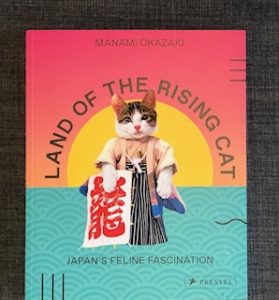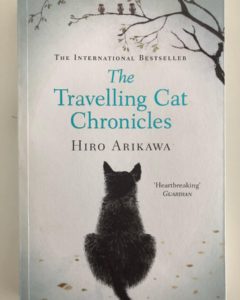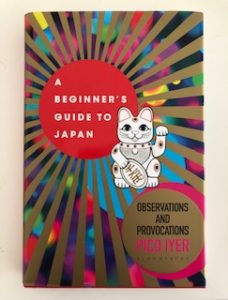5 (+1) Books from the Land of the Rising Cat
When I first came across the title of the book ‘Land of the Rising Cat: Japan’s Feline Fascination’, I knew I had to read it. On the one hand, even though I have never been to the land of the rising cat… sorry, the land of the rising sun, I’ve always been fascinated by the Japanese culture and pretty much anything else Japanese (including literature). On the other hand, I have been an ailurophile for as long as I remember…

About a year ago, I published the post ‘5 (+1) Japanese novels to read in 2020’, where I recommended some Japanese books I’d read and loved, and also mentioned some that I had bought but not read yet.

Then, in March 2020, I published the post ‘Best London bookstores, tsundoku & bibliotherapy’, where I discussed the Japanese concept of tsundoku. Tsundoku (not to be confused with sudoku) is a combination of the Japanese words for ‘piling up’ (tsunde oku) and ‘reading’ (dokusho). The concept refers to the habit of buying books (or, is it an art?), and storing them (piling them up) without actually reading them.
Previously ‘guilty’ of tsundoku myself, I am now pleased to say that I’ve read the vast majority of those books patiently waiting on my bookshelves.
Reading and mental health
A few days ago, I came across an interesting Canadian study published last year, which confirmed what we’d long suspected: that recreational reading can be beneficial for one’s mental health. The participants in this study were 231 university students. The findings provided plenty of food for thought. Specifically, the authors concluded that ‘recreational reading was associated with reduced psychological distress over the school year, it seemed to buffer against the frustration of one’s basic psychological needs which led to improved mental health over the school year, and overall it is a simple and cost-effective tool to help college students cope with mental health problems’.
Japanese literature and cats
So, today, I am going to discuss not only the ‘Land of the Rising Cat’, but also 4 Japanese novels with feline protagonists. I will also discuss the book ‘A Beginner’s Guide to Japan: Observations and Provocations’. Although this is a book about Japan, and not about cats, there is a very good reason why I have included it in this post.
‘Land of the Rising Cat: Japan’s Feline Fascination’, by Manami Okazaki
Having been fascinated by Japan since a young age, I hadn’t failed to notice the popularity of cats in the Japanese culture and life. The cat figurine known as maneki-neko (beckoning cat) is a prime example. Hello Kitty is another. In the recent years, cat cafés have blossomed around the country (although the world’s first cat café actually opened in Taiwan). Then, there is Maru, possibly the most popular cat on YouTube, a Scottish fold famous for his love for cardboard boxes. After reading the ‘Land of the Rising Cat’, I realised there is much more to this than that: from cat-themed museums to shrines, temples, and even islands famous for their feline residents. Now, the only thing that remains is to visit Japan and embark on a cat lovers trail.
‘The Travelling Cat Chronicles’, by Hiro Arikawa
This is another book I simply knew I had to read the moment I came across its title, a phrase including two of the things I love the most: cats and travelling. A beautifully written novel, it follows a man and his cat around Japan. While the protagonist visits friends and family in search of a new home for his beloved cat, he also re-visits his past. A film adaptation was released in 2018 directed by Kôichirô Miki.
‘The Guest Cat’, by Takashi Hiraide
There is a famous quote by the American author Kristin Cast: “Cats choose us; we don’t own them”. This is the premise of this book by Takashi Hiraide, where a cat sneaks out and spends time with a young couple, rather than its legitimate owners.
‘If Cats Disappeared From The World‘, by Genki Kawamura
A young man finds out that he has a terminal illness and he will die soon. Then, the devil appears offering to prolong his life one day at a time, as long as he chooses one thing to disappear from the world. How much is he willing to sacrifice and how far is he prepared to go? A film adaptation was released in 2016.
‘A Cat, a Man, and Two Women’, by Jun’ichiro Tanizaki
Jun’ichirō Tanizaki is considered one of the major writers of modern Japanese literature. ‘A Cat, a Man, and Two Women’ was first published (in Japanese) in the 1930s. As the title suggests, the protagonists are a man (Shozo), his cat (Lily), and his two wives: his ex (Shinako) and his current (Fukuko). Oblivious to the complex relationships between the human protagonists, Lily becomes the object of a custody battle between Shinako and Shozo/Fukuko, and succeeds in transforming the latter from a vengeful betrayed woman to a kind human being. A film adaptation, ‘Shozo, a Cat and Two Women’, was released in 1956.
‘A Beginner’s Guide to Japan: Observations and Provocations’, by Pico Iyer
This is a book about Japan, but not about cats. So, why have I included it in this list? Simply, because of its cover: a white maneki-neko (beckoning cat) against a backdrop of bright colours. British-born travel writer Pico Iyer is married to a Japanese wife and has been living in Japan for more than 32 years. In this book, he shares information and insight into the Japanese psyche and culture. His reflections are coloured not only by his life in Japan, but also by many Japanese novels and other works of literature he’s read. In a nutshell, ’A Beginner’s Guide to Japan’ is not only a beautifully-written but also a very informative book about the land of the rising sun.

Further reading
Check out my post ‘Ikigai & Komorebi: Finding purpose & beautiful moments’.
Alex
(the Traveling Psychiatrist)